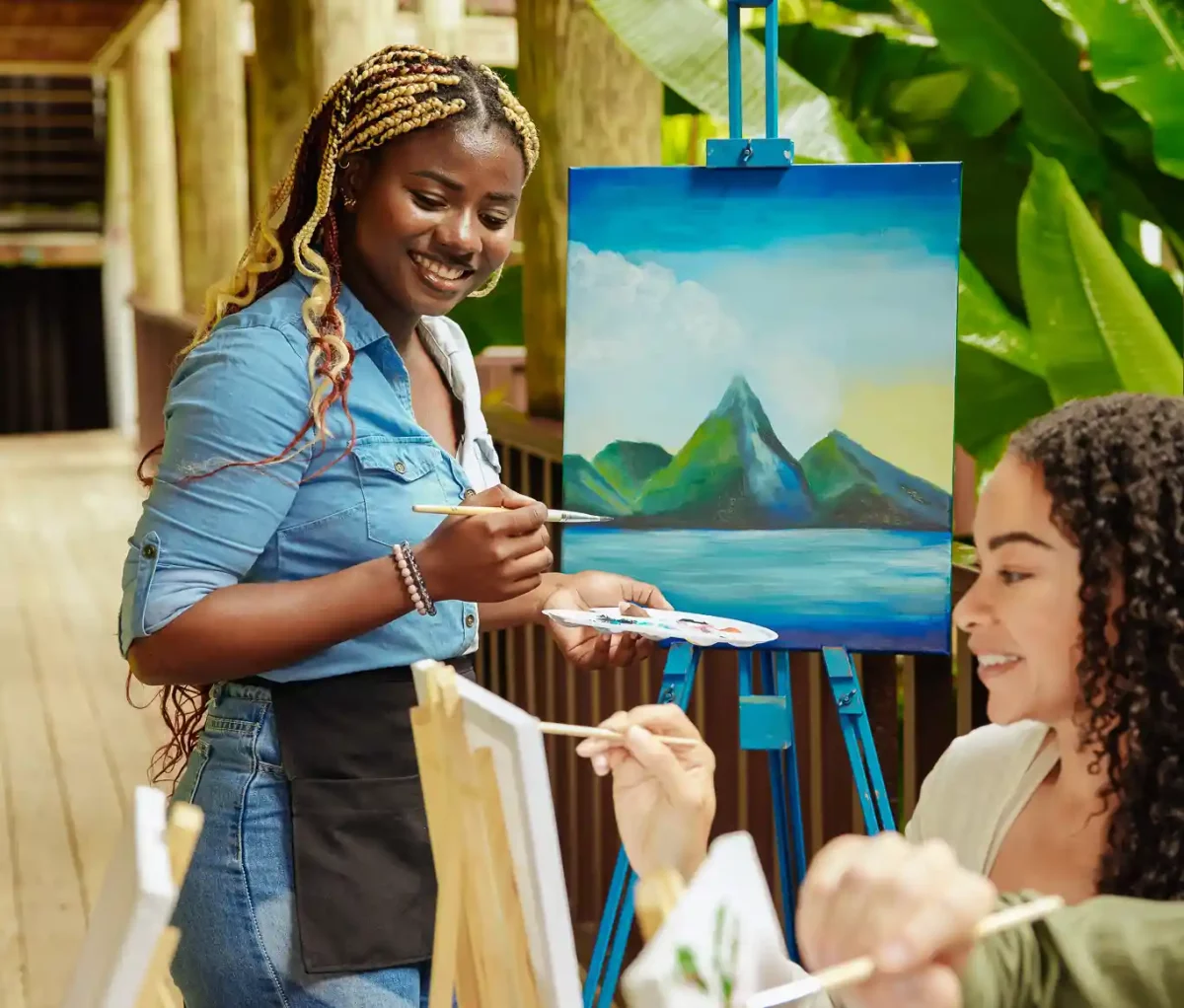At StolenTime, you will find distractions that are both creative and restful. Arts and crafts contribute to our experience of interacting with each other and form part of our mindfulness. We call them Stolen Moments
The Value and Benefits of Arts and Crafts for Mindfulness and Mental Health
In an increasingly fast-paced and digital world, mental health issues such as anxiety, stress, and depression are on the rise. Finding effective methods to enhance mental well-being has become a priority for many individuals. One often overlooked yet highly beneficial approach is engaging in arts and crafts. Creative activities such as painting, drawing, sketching, basket weaving, sculpting, wood carving, jewellery making, and cooking provide not only an outlet for self-expression but also serve as powerful tools for mindfulness and mental health. These activities cultivate a sense of presence, relaxation, and personal satisfaction, promoting emotional balance and resilience.
Mindfulness Through Arts and Crafts
Mindfulness is the practice of being fully present in the moment, aware of one’s thoughts, feelings, and surroundings without judgment. Engaging in arts and crafts naturally encourages mindfulness by requiring focus, patience, and attention to detail. Whether it’s the steady hand needed for painting delicate strokes on a canvas or the rhythmic weaving of a basket, these activities ground individuals in the present moment, helping them disconnect from intrusive thoughts and external stressors.
Crafting activities often involve repetitive motions that can induce a meditative state. The steady process of knitting, for example, has been likened to the calming effects of deep breathing exercises. Similarly, sculpting or wood carving demands a slow and intentional approach, fostering a deep connection between the artist and their creation. This process allows individuals to enter a flow state, a mental state in which they become fully immersed in an activity, resulting in reduced stress and heightened focus.
Stress Reduction and Emotional Rescue
Creating art can be a powerful form of stress relief. Engaging in arts and crafts provides a constructive way to channel negative emotions, frustration, and anxiety. Instead of ruminating on stressful thoughts, individuals can redirect their energy into a creative endeavor, transforming distress into something tangible and meaningful. This is particularly beneficial for those who struggle with verbalizing their emotions, as art allows for non-verbal expression and emotional release.
The sensory aspects of many craft activities also contribute to stress reduction. The tactile experience of shaping clay, the smooth strokes of a paintbrush, or the aroma of freshly baked bread can stimulate the senses, grounding individuals in the present moment. Studies have shown that engaging in such creative activities can lower cortisol levels, the hormone associated with stress, thereby promoting relaxation and overall well-being.
Building Self-Esteem and Confidence
Arts and crafts allow individuals to develop new skills and create something from nothing, fostering a sense of accomplishment and pride. Completing a project, whether it’s a painting, a handmade piece of jewelry, or a carefully woven basket, provides a tangible representation of effort and creativity. This sense of achievement boosts self-esteem and confidence, encouraging individuals to take on new challenges both in their artistic endeavors and in daily life.
The learning process involved in crafting also plays a crucial role in building resilience. Making mistakes is a natural part of any creative process, and overcoming these challenges teaches patience and perseverance. Whether it’s reworking a sculpture that didn’t turn out as expected or starting over on a piece of embroidery, the act of pushing through difficulties fosters adaptability and problem-solving skills.
Social Connection and Community
Many arts and crafts activities can be enjoyed in a social setting, providing opportunities for connection and support. Participating in a pottery class, joining a knitting circle, or attending a cooking workshop allows individuals to share experiences, exchange ideas, and build meaningful relationships. Engaging in creative activities with others fosters a sense of belonging and reduces feelings of loneliness and isolation.
Art-based therapy groups and community craft projects have also been shown to have profound mental health benefits. Creating something collectively strengthens interpersonal bonds, encourages collaboration, and provides a supportive space for self-expression. For individuals experiencing social anxiety or depression, participating in such groups can serve as a gentle and enjoyable way to reconnect with others.
Cognitive Benefits and Mental Agility
Beyond emotional and social benefits, engaging in arts and crafts also promotes cognitive health. Creative activities stimulate the brain, enhancing memory, problem-solving abilities, and fine motor skills. Drawing and sketching, for example, require spatial awareness and hand-eye coordination, while woodworking involves precision and careful planning. Engaging in such tasks keeps the mind active and sharp, which is particularly beneficial for older adults in preventing cognitive decline and conditions such as dementia.
The process of engaging in creative activities also encourages divergent thinking, which is the ability to generate multiple solutions to a problem. This fosters a flexible mindset and enhances one’s ability to think creatively in other aspects of life, from professional endeavors to personal problem-solving.
Therapeutic Potential of Arts and Crafts
Art therapy has long been recognized as an effective approach to mental health treatment. Many therapists incorporate creative activities into their practice to help individuals process trauma, express emotions, and develop coping mechanisms. Engaging in structured creative exercises can provide a safe outlet for individuals dealing with grief, PTSD, or other psychological challenges.
For example, coloring books for adults have gained popularity as a therapeutic tool for stress relief. The act of coloring intricate patterns requires focus and patience, similar to meditation, making it an accessible and effective way to calm the mind. Similarly, journaling with visual elements, such as doodling or collaging, allows individuals to express emotions in a way that words sometimes cannot capture.
Conclusion
The value of arts and crafts extends far beyond mere hobby or recreation; it is a deeply enriching practice that nurtures mindfulness, emotional well-being, and cognitive health. By engaging in creative activities such as painting, drawing, sculpting, or woodworking, individuals can cultivate mindfulness, reduce stress, enhance self-esteem, and strengthen social connections. The therapeutic benefits of crafting provide a holistic approach to mental health, offering a fulfilling and meaningful way to navigate life’s challenges. In an era where stress and anxiety are prevalent, embracing creativity may just be one of the most effective ways to achieve inner balance and overall well-being.



